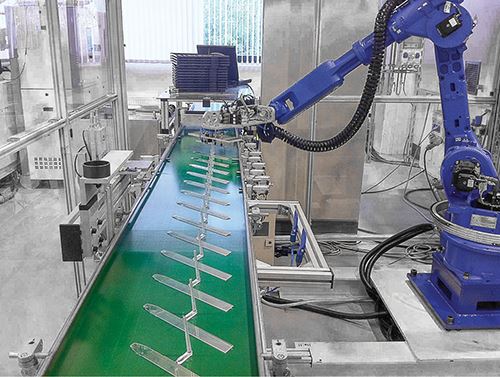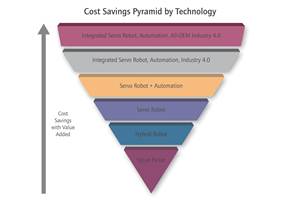Advanced Styrenic Lets Molder Shed New Light On Automotive Part
Polyoptics teamed up with Styrolution to develop a ‘breakthrough’ process for light guides.
An emerging leader in optical technology, Polyoptics GmbH has pioneered new technology to injection mold light guides in a single step without any refinishing operations. A high-precision tool insert with a complex laser-processing transverse uncouple structure reduces the production time of a light guide by two-thirds.
These guides are used in applications such as backlight effects in automotive interiors.
Based in Kleve, Germany, the company partnered with global styrenics supplier Styrolution, Aurora, Ill. , on a “breakthrough” technology in this arena, and a new advanced styrenic material was instrumental in its success.
The key purpose of the project was to optimize—both in production time and quality—the current process for manufacturing light guides. That process consists of three successive steps that take a total of 3 minutes: production of transparent plastic plates using extrusion or calendering; cutting light-guide shapes out of the plates with a laser; and creating the complex uncouple structure with laser processing. Moreover, Polyoptic estimates that the third step typically has a 50% failure rate. The new technology has a 60 sec/unit production time and a failure rate of just 8%.
Polyoptics’ technology consists of two major innovations: Optical simulation calculations to zero in on the optimal uncouple structure pattern; and precision tool inserts made via laser processing or laser lithography. The former was used to investigate different uncouple structures. Arrangements of spherical caps, disks, and/or prisms are suitable for light guides. The structures could be either raised or embedded in the guide. The shape, density, angles, and depth of the structure depend on the guide’s geometry and the effect that is intended to be realized. With increasing distance from the light source, the height and diameter of the elements increase to achieve a homogeneous luminous density distribution.
The diamond-turning process used to produce other precision tool inserts is limited by the size of the diamond and the geometry of the “hole to be dug,” says Polyoptics. In case of the light guide, this method is not suitable because the elements are too tiny and the diamond would destroy the top edge of the hole. Reducing the size of the diamond is an option, but the smaller the diamond, the bigger the risk that it will break, Polyoptics explains.
Polyoptics’ first light guides were manufactured using PC. But in 2014, the firm tested Styrolution’s NAS styrene-methyl methacrylate-copolymer. Compared with PC, NAS showed advantages in both processing and optics. Its better flow leads to lower energy consumption and shorter cycles and makes it easier to fill out more complex, thin-walled shapes. The higher light transmission of NAS increases the luminous density, optimizing the output of the light guides without increasing the power of the light source.
Polyoptics’ engineers say their new technology is perfect for high-volume manufacturing and a perfect fit for automotive, especially for interior lighting. Polyoptics is in negotiations with automotive OEMs to apply its new light-guide technology to doorsteps and ambient lighting for controls and instruments. There is also interest from other industries like electronics.
Polyoptics offers optical engineering, ultra-precision tooling, production, and optical coating. Polyoptics molds the light guides on presses with clamping forces from 25 tons up to 500 tons. All are equipped with automation systems in a cleanroom environment.
Related Content
Ensuring Repeatability: The Key to Effective Injection Molding Automation
One of automation’s key promises is repeatability: the same movement to the same location, time and time again. But to achieve that, all elements involved — robot, machine, EOAT, mold — must be in and stay in alignment.
Read MoreAutomation in Thermoforming on the Rise
Equipment suppliers’ latest innovations exemplify this trend driven by factors such as labor shortages, higher-speed thermoformers and tighter quality control.
Read MoreAutomation Evolution: From Robots to Work Cells, Solo Devices to Integrated Systems
Injection molding automation has progressed from devices to systems, from simplicity to more complex capabilities. The author traces this development through various levels of automation – all still available choices today – and analyzes the costs and capabilities for each level.
Read MoreReal-Time Production Monitoring as Automation
As an injection molder, Windmill Plastics sought an economical production monitoring system that could help it keep tabs on its shop floor. It’s now selling the “very focused” digital supervisor it created, automating many formerly manual tasks.
Read MoreRead Next
How Polymer Melts in Single-Screw Extruders
Understanding how polymer melts in a single-screw extruder could help you optimize your screw design to eliminate defect-causing solid polymer fragments.
Read MoreAdvanced Recycling: Beyond Pyrolysis
Consumer-product brand owners increasingly see advanced chemical recycling as a necessary complement to mechanical recycling if they are to meet ambitious goals for a circular economy in the next decade. Dozens of technology providers are developing new technologies to overcome the limitations of existing pyrolysis methods and to commercialize various alternative approaches to chemical recycling of plastics.
Read MoreProcessor Turns to AI to Help Keep Machines Humming
At captive processor McConkey, a new generation of artificial intelligence models, highlighted by ChatGPT, is helping it wade through the shortage of skilled labor and keep its production lines churning out good parts.
Read More




























